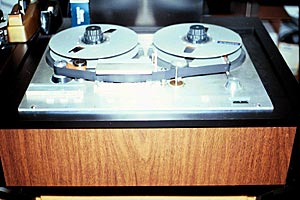
My Year at AMPEX page 2

 |
My Year at AMPEX page 2 |
 |
The master tapes had an interesting story in and of themselves. In a fairly sound-deadened back room off the side of the factory floor, was a studio setup including an Ampex (what else?) eight channel studio recording deck complete with all the amplifiers and patch cords and so forth. There the master tapes for the production lines were made. They were most often duplicated from other masters, and depending upon how popular a particular recording was, there could be eight or ten duplicate masters running on the production floor simultaneously (such as the sound track to the movie "Woodstock").
 |
| Mastering Deck. This machine records the 1" tape that is later fed into the Master Playback Machine (previous page). The tape has eight tracks, just like an 8-track tape, and is recorded by sound engineers from master tapes provided by the recording studios. |
These production master tapes were themselves copied from actual studio master copies. I had the wonderful experience of hearing much of Jimi Hendrix's "Electric Ladyland" directly from one of these tapes as a production master was being made. It was the cleanest, highest fidelity sound reproduction I had ever heard at the time, and it pretty much spoiled pre-recorded music for me for years until CDs finally came along. When you consider that this room also had studio monitor grade speaker systems and super high fidelity amplifiers and mixers installed, well you get the idea. You really felt like the musicians were sitting there with you. Even nearly thirty years later all I can say is that it was awesome.
The technicians that worked in this room also had the capability to produce masters from vinyl records. There was a very ponderous looking and totally professional turntable with variable speed drive, a huge heavy turntable platter and a manual tone arm installed. It was mounted on a pedestal having some sort of compliant balloon or other cushion (I never saw it with the cover off), and a heavy granite or dark concrete slab beneath the turntable itself. Someone told me with a completely straight face that it contained a "lead" balloon, but I never took them seriously. Whatever it really was, its purpose was to isolate the turntable from floor vibrations and noises as much as possible. If a recording was very old, or if there were no surviving master studio tapes, they could clean up a record and reproduce it quite nicely. Of course there was no way to get rid of the worst of the scratches and pops. There are quite a few pre-recorded tapes from that era that sound like recordings of records because in fact that's what they are.
Now for a sore subject for any truly dyed-in-the-wool 8-track owner/enthusiast. Why the !xBss#e!!$55@ did they chop up songs where they did for the track splits? Well, of course you know that the media itself doesn't lend itself to a continuous recording. For one thing the sensor tape will cause a momentary dropout as it passes over the tape head, and for another as I have explained, there was the necessary 20-hertz channel switch tone that signaled the end of the loop for the winding machines. There also had to be some finite amount of "dead" tape on either side of the splice because the winding and splicing machines could only respond just so fast. These were some of the compromises necessary for mass production.
Most of the folks who did the masters did a really good job of it and tried hard not to chop up anyone's favorite songs. You will notice that the later cartridges often times had extended blank spots on the track ends where the editor just flat out gave up trying to reorganize the record tracks into equal-length sections. If an editor was really considerate, they would warn you by putting a "2:13 silence" notation on the play list or something like that. However, in any such endeavor, there are those folks who really grooved on say, Bing Crosby or Hank Williams and who could give a green flying leap about the latest lyrical offerings from Mott the Hoople, The MC5, Aretha Franklin or The Nazz, much less expressing any recognizable form of sensitivity regarding the seemingly 15 second long fade outs and fade ins they put around the track switches. Remember this was close to 30 years ago, and the record business was structured a lot differently. I would imagine that nowadays you'd have the artists, their agents, or their attorneys screaming bloody murder if someone chopped up their songs like that.
Now I like the Crooner and old Hank as much as the next guy, so please don't flame me with e-mails, I only used them as an example of an apparent attitude. I still have some 8-tracks that irritate me to no end at how they were edited. I personally protested about the fades and splits whenever and to whomever I got a chance. After a while I think they didn't want to talk to me anymore.
And let's not forget the "cheap" factor. As the market for 8-track tapes declined, there was more and more pressure to get it done quickly (i.e., cheaply). Add this to a healthy dose of "who'll be listening to this stuff a year from now anyway," and it isn't hard to see why they faded out and in again in the middle of Chicago's "25 or 6 to 4" on one tape I have (a Columbia, not an Ampex) when they could have slightly rearranged the songs and avoided it altogether. Of course maybe the artists or producers nixed the shuffling of the song order, I never found out. I doubt if they were consulted. Sorry, it wasn’t my fault..... really!